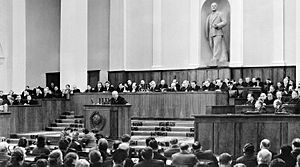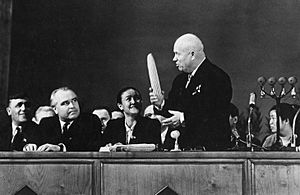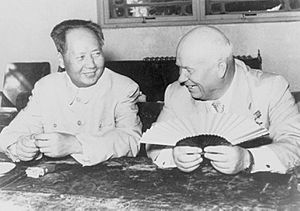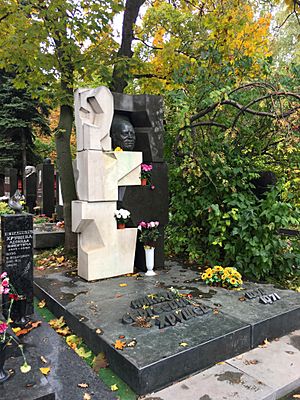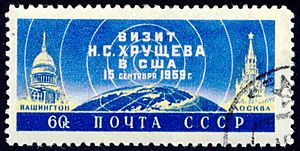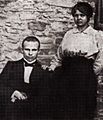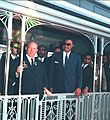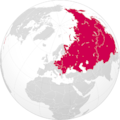Nikita Khrushchev facts for kids
Quick facts for kids
Nikita Khrushchev
Никита Хрущёв |
|
|---|---|
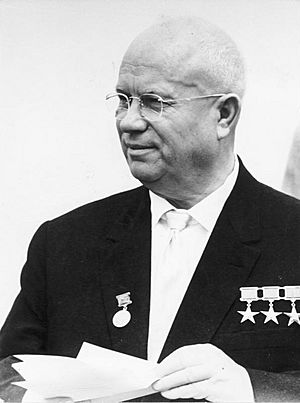
Khrushchev in East Berlin during a visit to East Germany in 1963
|
|
| First Secretary of the Communist Party of the Soviet Union | |
| In office September 14, 1953 – October 14, 1964 |
|
| President | Kliment Voroshilov Leonid Brezhnev Anastas Mikoyan |
| Premier | Georgy Malenkov Nikolai Bulganin Himself |
| Preceded by | Joseph Stalin |
| Succeeded by | Leonid Brezhnev |
| Premier of the Soviet Union | |
| In office March 27, 1958 – October 14, 1964 |
|
| President | Kliment Voroshilov Leonid Brezhnev Anastas Mikoyan |
| First Deputies | Frol Kozlov Alexei Kosygin Dmitriy Ustinov Lazar Kaganovich Anastas Mikoyan |
| Preceded by | Nikolai Bulganin |
| Succeeded by | Alexei Kosygin |
| Personal details | |
| Born | 15 April 1894 Kalinovka, Dmitriyevsky Uyezd, Kursk Governorate, Russian Empire |
| Died | September 11, 1971 (aged 77) Moscow, Russian SFSR, Soviet Union |
| Nationality | Soviet |
| Political party | Communist Party of the Soviet Union |
| Spouses | Yefrosinia Khrushcheva (1916–1919, died) Marusia Khrushcheva (1922, separated) Nina Khrushcheva (1923–1971, survived as widow) |
| Signature |  |
Nikita Sergeyevich Khrushchev (15 April 1894 – 11 September 1971) was the leader of the Soviet Union after the death of Joseph Stalin. He ruled from 1953 to 1964 when Leonid Brezhnev, a Red Army Major General and President of the Soviet Union from 1960 to 1964 (during Khrushchev's own rule) came to power in 1964 after a bloodless palace coup against Khrushchev, just 11 years after Stalin died.
He supported the Soviet space program and was the leader when Yuri Gagarin flew into space and became the first man to leave Earth in April 1961. Khrushchev was also the leader who ordered the Berlin Wall to be built in the East Berlin half of the former Nazi capital city Berlin. The wall separated it from West Berlin in August 1961 until the end of the Cold War .
Contents
Early life and career
Nikita was born in the town of Kalinovka in Russia. He later moved to Ukraine. He worked in mines, and became part of the Bolshevik movement. He was a political commissar in the Red Army in the Russian Civil War and again in World War II and moved his way up in the Communist Party, eventually becoming trusted by Joseph Stalin. When Stalin died, Georgy Malenkov and several others including Khrushchev shared power. Eventually Khrushchev became the leader.
Domestic policies
"De-Stalinization"
When Nikita became the leader of the Soviet Union, he began something he called "De-Stalinization". He made a secret speech, in which he denounced Stalin as a man who committed many murders of innocent people. In early 1956, he took down all posters and statues of Joseph Stalin. Also, he moved Stalin's grave to a place where people could not see it.
Liberalization and the arts
After assuming power, Khrushchev allowed a modest amount of freedom in the arts.
Khrushchev believed that the USSR could match the West's living standards, and was not afraid to allow Soviet citizens to see Western achievements. Stalin had permitted few tourists to the Soviet Union, and had allowed few Soviets to travel. Khrushchev let Soviets travel (over two million Soviet citizens travelled abroad between 1957 and 1961, 700,000 of whom visited the West) and allowed foreigners to visit the Soviet Union, where tourists became subjects of immense curiosity.
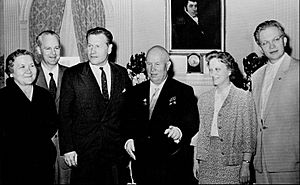
In 1962, Khrushchev, impressed by Aleksandr Solzhenitsyn's One Day in the Life of Ivan Denisovich, persuaded the Presidium to allow publication. That renewed thaw ended on 1 December 1962, when Khrushchev was taken to the Manezh Gallery to view an exhibit which included a number of avant-garde works. On seeing them, Khrushchev exploded with anger, an episode known as the Manege Affair, proclaiming that "a donkey could smear better art with its tail". A week later, Pravda issued a call for artistic purity. When writers and filmmakers defended the painters, Khrushchev extended his anger to them. However, despite the premier's rage, none of the artists were arrested or exiled.
Political reform
Under Khrushchev, the special tribunals operated by security agencies were abolished. These tribunals, known as troikas, had often ignored laws and procedures. Under the reforms, no prosecution for a political crime could be brought even in the regular courts unless approved by the local Party committee. This rarely happened; there were no major political trials under Khrushchev, and at most several hundred political prosecutions overall. Instead, other sanctions were imposed on Soviet dissidents, including loss of job or university position, or expulsion from the Party.
Agricultural policy
Khrushchev was an expert on agricultural policies and sensed an urgent need to reform the backward, inefficient system with ideas that worked in the United States. He looked especially at collectivism, state farms, liquidation of machine-tractor stations, planning decentralization, economic incentives, increased labor and capital investment, new crops, and new production programs. Henry Ford had been at the center of American technology transfer to the Soviet Union in the 1930s; he sent over factory designs, engineers, and skilled craftsmen, as well as tens of thousands of Ford tractors. By the 1940s Khrushchev was keenly interested in American agricultural innovations, especially on large-scale family-operated farms in the Midwest. In the 1950s he sent several delegations to visit farms and land grant colleges, looking at successful farms that utilized high-yielding seed varieties, very large and powerful tractors and other machines, all guided by modern management techniques. Especially after his visit to the United States in 1959, he was keenly aware of the need to emulate and even match American superiority and agricultural technology.
Khrushchev became a hyper-enthusiastic crusader to grow corn (maize). He established a corn institute in Ukraine and ordered thousands of hectares to be planted with corn in the Virgin Lands. In 1955, Khrushchev advocated an Iowa-style corn belt in the Soviet Union, and a Soviet delegation visited the U.S. state that summer. The delegation chief was approached by farmer and corn seed salesman Roswell Garst, who persuaded him to visit Garst's large farm. The Iowan visited the Soviet Union, where he became friends with Khrushchev, and Garst sold the USSR 4,500 metric tons (5,000 short tons) of seed corn. Garst warned the Soviets to grow the corn in the southern part of the country and to ensure there were sufficient stocks of fertilizer, insecticides, and herbicides. This, however, was not done, as Khrushchev sought to plant corn even in Siberia, and without the necessary chemicals. The corn experiment was not a great success, and he later complained that overenthusiastic officials, wanting to please him, had overplanted without laying the proper groundwork, and "as a result corn was discredited as a silage crop—and so was I".
Khrushchev sought to abolish the Machine-Tractor Stations (MTS) which not only owned most large agricultural machines such as combines and tractors but also provided services such as plowing, and transfer their equipment and functions to the kolkhozes and sovkhozes (state farms). After a successful test involving MTS which served one large kolkhoz each, Khrushchev ordered a gradual transition—but then ordered that the change take place with great speed. Within three months, over half of the MTS facilities had been closed, and kolkhozes were being required to buy the equipment, with no discount given for older or dilapidated machines. MTS employees, unwilling to bind themselves to kolkhozes and lose their state employee benefits and the right to change their jobs, fled to the cities, creating a shortage of skilled operators. The costs of the machinery, plus the costs of building storage sheds and fuel tanks for the equipment, impoverished many kolkhozes. Inadequate provisions were made for repair stations. Without the MTS, the market for Soviet agricultural equipment fell apart, as the kolkhozes now had neither the money nor skilled buyers to purchase new equipment.
In the 1940s Stalin put Trofim Lysenko in charge of agricultural research, with his ideas that flouted modern genetics science. Lysenko maintained his influence under Khrushchev, and helped block the adoption of American techniques. In 1959, Khrushchev announced a goal of overtaking the United States in the production of milk, meat, and butter. Local officials kept Khrushchev happy with unrealistic pledges of production. These goals were met by farmers who slaughtered their breeding herds and by purchasing meat at state stores, then reselling it back to the government, artificially increasing recorded production.
In June 1962, food prices were raised, particularly on meat and butter, by 25–30%. This caused public discontent. In the southern Russian city of Novocherkassk (Rostov Region), this discontent escalated to a strike and a revolt against the authorities. The revolt was put down by the military, resulting in a massacre that killed 22 people and wounded 87 according to Soviet official accounts. In addition, 116 demonstrators were convicted of involvement and seven of them executed. Information about the revolt was completely suppressed in the USSR, but spread through Samizdat and damaged Khrushchev's reputation in the West.
Drought struck the Soviet Union in 1963; the harvest of 97,500,000 t (107,500,000 short tons) of grain was down from a peak of 122,200,000 t (134,700,000 short tons) in 1958. The shortages resulted in bread lines, a fact at first kept from Khrushchev. Reluctant to purchase food in the West, but faced with the alternative of widespread hunger, Khrushchev exhausted the nation's hard currency reserves and expended part of its gold stockpile in the purchase of grain and other foodstuffs.
Education
Khrushchev founded several academic towns, such as Akademgorodok. The premier believed that Western science flourished because many scientists lived in university towns such as Oxford, isolated from big-city distractions, and had pleasant living conditions and good pay. He sought to duplicate those conditions in the Soviet Union. Khrushchev's attempt was generally successful, though his new towns and scientific centres tended to attract younger scientists, with older ones unwilling to leave Moscow or Leningrad.
Khrushchev also proposed to restructure Soviet high schools. While the high schools provided a college preparatory curriculum, in fact, few Soviet youths went on to university. Khrushchev wanted to shift the focus of secondary schools to vocational training: students would spend much of their time at factory jobs or in apprenticeships and only a small part at the schools. In practice, schools developed links with nearby enterprises and students went to work for only one or two days a week; the organizations disliked having to teach, while students and their families complained that they had little choice in what trade to learn.
While the vocational proposal would not survive Khrushchev's downfall, a longer-lasting change was a related establishment of specialized high schools for gifted students or those wishing to study a specific subject. These schools were modeled after the foreign-language schools that had been established in Moscow and Leningrad beginning in 1949. By the early 1970s, over 100 specialized schools had been established, in mathematics, the sciences, art, music, and sport. Preschool education was increased as part of Khrushchev's reforms, and by the time he left office, about 22% of Soviet children attended preschool—about half of urban children, but only about 12% of rural children.
Anti-religious campaign
The anti-religious campaign of the Khrushchev era began in 1959, coinciding with the 21st Party Congress in the same year. It was carried out by mass closures of churches (reducing the number from 22,000 in 1959 to 13,008 in 1960 and to 7,873 by 1965), monasteries, convents, and still-existing seminaries. The campaign also included a restriction of parental rights to teach religion to their children; a ban on the presence of children at church services (beginning with the Baptists in 1961, it was then extended to the Orthodox in 1963); and a ban on the administration of the Eucharist to children over the age of four. Khrushchev additionally banned all services held outside of churches' walls, renewed enforcement of 1929 legislation banning pilgrimages, and recorded the personal identities of all adults requesting church baptisms, weddings, or funerals. He also disallowed the ringing of church bells and services in daytime in some rural settings from May to the end of October under the pretext of fieldwork requirements. Non-fulfillment of these regulations by clergy would lead to disallowance of state registration; meaning clergy could no longer do any pastoral or liturgical work without special state permission).
Relations with the "West"

He also had better contacts with the western countries like the USA, Britain, and France. This means the USSR and the western world were friendlier. He visited America in 1959. During this visit, Khrushchev spoke at the United Nations and visited where he wanted, including destinations such as New York and Hollywood. However, his visit to Disneyland was cancelled for security reasons.
But the USSR and the US still did not trust each other. In 1962 America and the USSR had a Cuban Missile Crisis which could have led to nuclear war, but didn't. Khrushchev had bargained with the Americans to get rid of the missiles they had placed in Turkey, for the missiles in Cuba were the only way for withdrawal.
Relations with China
During the period of "De-Stalinization", relations deteriorated between the Soviet Union and China. These policies were viewed by Mao Zedong and the Chinese Communist Party as divergences in the two states interpretations of Marxist-Leninist Doctrine. The resulting tensions were a contributing factor to the Sino-Soviet Split.
Later years and Death
Khrushchev's removal in 1964 was a result of political opposition within the Soviet leadership, citing economic failures and his handling of the Cuban Missile Crisis. His ousting marked a shift in Soviet leadership dynamics. After his removal in 1964, he lived a relatively quiet life, writing his memoirs and staying out of politics. His later years were marked by a retreat from the public eye until his death in 1971.
Legacy
Khrushchev's legacy is marked by significant events like the Cuban Missile Crisis and his efforts at de-Stalinization in the Soviet Union. His impact on Soviet policies and relations with the West shaped the Cold War era.
Images for kids
-
Lazar Kaganovich, one of the chief enforcers of Stalin's dictatorship and Khrushchev's main patron.
-
Khrushchev (second from right) poses for a photo alongside Joseph Stalin (far right) sometime during the 1930s.
-
Regional party leaders in 1935. In the front row sits Nikita Khrushchev (Moscow), Andrei Zhdanov (Leningrad), Lazar Kaganovich (Ukraine), Lavrentiy Beria (Georgia), and Nestor Lakoba (Abkhazia) (behind him stands Mir Jafar Baghirov).
-
A photo of the Ukrainian capital of Kiev after being devastated by the Second World War.
-
Georgy Malenkov, the man who briefly succeeded Stalin as leader of the Soviet Union.
-
Khrushchev featured on the November 1953 cover of TIME after becoming First Secretary of the Communist Party
-
General Secretary Khrushchev speaking before the 20th CPSU Congress in 1956
-
Khrushchev, his wife, his son Sergei (far right) and his daughter Rada during their trip to USA in 1959
-
Khrushchev (right) with cosmonauts Yuri Gagarin, Pavel Popovich and Valentina Tereshkova, 1963
-
Khrushchev and Egyptian President Gamal Abdel Nasser aboard a train returning to Cairo from Alexandria, during a visit by Khrushchev to Egypt, 1964.
-
Khrushchev with Vice President Richard Nixon, 1959
-
Khrushchev featured as Time Magazine's Man of the Year for 1957 after the launch of Sputnik
-
Khrushchev with Agriculture Secretary Ezra Taft Benson (left of Khrushchev) and U.S. Ambassador to the United Nations Henry Cabot Lodge (far left) during his visit on 16 September 1959 to the Agricultural Research Service Center
-
Khrushchev and John F. Kennedy, Vienna, June 1961
-
The maximum territorial extent of countries in the world under Soviet influence, after the Cuban Revolution of 1959 and before the official Sino-Soviet split of 1961
-
Khrushchev & Gheorghe Gheorghiu-Dej at Bucharest's Băneasa Airport in June 1960. Nicolae Ceaușescu can be seen at Gheorghiu-Dej's right hand side.
-
Khrushchev (left) and East German leader Walter Ulbricht, 1963
-
Nikita Khrushchev with Anastas Mikoyan (far right) in Berlin
-
Decree of the Presidium of the Supreme Soviet "On the transfer of the Crimean Oblast". In 1954, the Soviet leadership, which included Khrushchev, transferred Crimea from Russian SFSR to Ukrainian SSR.
See also
 In Spanish: Nikita Jrushchov para niños
In Spanish: Nikita Jrushchov para niños



